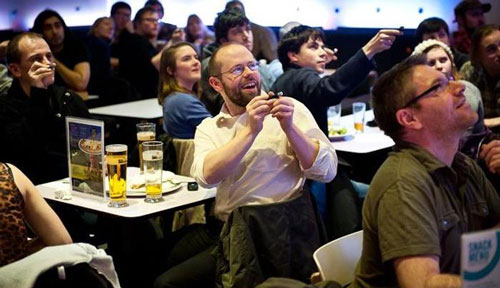
Adam Russell and John Sear don’t look like revolutionaries. Mild mannered, bespectacled and dry of wit, you’d never guess they were planning to change our entire idea of cinema. But that’s exactly what their project — interactive big screen entertainment — is aimed at doing.
If the name they’ve chosen is vague, it’s because the experience is hard to compress into a short phrase. It’s a combination of a cinema experience — you and 100 strangers in the dark together, staring at the same big screen — and a video game, with goals and obstacles to be overcome.
How do they achieve this? By giving people in the audience laser pointers that allow them to interact with objects and environments on the screen, as though each person had their own mouse pointer. Speaking at this year’s South By South West (SXSW) festival, they demonstrated their technology live, and had the normally aloof conference crowd whooping with laughter and excitement.
A hundred people flashing lasers at a screen sounds like a recipe for chaos, until you start playing Renga — the “feature length interactive experience” that the duo premiered at the SXSW Film Festival. Within minutes the entire audience is working together to protect the little spaceship that we’re now collectively commanding. Delight and anxiety are both palpable as goals are completed and enemies defeated.
That the game is so engrossing is no accident. Between them, Russell and Sear have decades of experience in the gaming industry, working on big budget releases. But, in true deferential Biritsh style, they are more keen to learn than to teach. “We’re from the gaming industry, and we’ve sort of accidentally stumbled into film. So there’s lots of people in this room that can help us more than we can help you,” says Sear.
It’s clear that the biggest challenge the pair have faced is not the technology itself, impressive as it is, but how to design interactive experiences for large numbers of simultaneous players. As Sear points out: “In the gaming industry we always say that software sells hardware. You can have the best console in the world, but until you have the game that people want, no one’s going to worry about it.”
For Russell, all games come down to a conversation between the player and the machine. The big question then is, how can a crowd of people all have a conversion simultaneously? “We’ve realised that we need to offer many different points of interaction on the same screen.” Like other examples of “crowd” intelligence — such as Wikipedia — this means that people need not agree on the specifics in order to contribute to the whole.
Russell draws a parallel between the development of computer generated images (CGI), and interactive big screen entertainment. CGI started out as a plaything for scientists but eventually grew into an entire branch of the entertainment industry still led by the original pioneers, Pixar.
“No one has the technology installed at the moment, so we end up carrying it around with us, which harks back to the early days of cinema,” explains Russell.
But how do you keep 100 people involved in a game for two hours? “We’re making games as theatre, a kind of theatrical experience,” says Russell. This doesn’t necessarily imply a traditional plot structure. He explains the daunting challenges involved in making a truly “systemic” interactive narrative. For instance a team at the University of California Santa Cruz spent 5 years making a 15 minute long interactive narrative about two people in a single room.
Renga may not have a narrative in the traditional sense but it has three “acts” and a very clear end. In some ways it’s still closer to a kind of collaborative chess game than to a traditional feature film. For Russell what separates it from “asynchronous” games like chess is the “liveness” of the interaction — the theatrical nature of a simultaneously shared experience.
I was sceptical of this neat theory, until we started actually playing some of the games cooked up by WallFour (Russell and Sear’s big screen gaming start-up). Something quite magical happens as soon as the interaction begins — you and a whole crowd of strangers are suddenly playing together, simultaneously, with a kind of shared toy. It may take some time before this gets to mainstream audiences, but as far as I’m concerned it’s just a question of “when”, not “if”. — Alistair Fairweather, TechCentral
- Image: WallFour
- Subscribe to our free daily newsletter
- Follow us on Twitter or on Google+ or on Facebook
- Visit our sister website, SportsCentral (still in beta)

